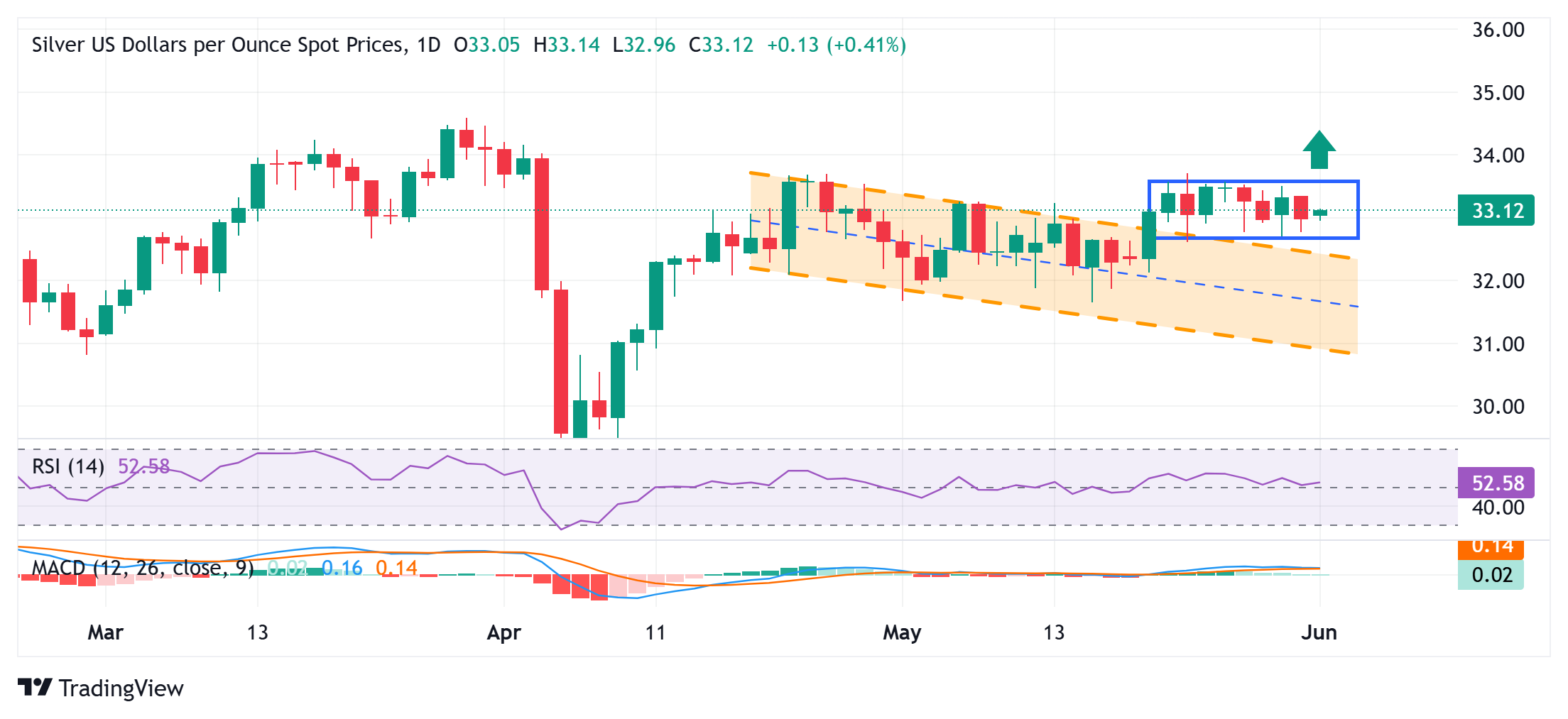Silver Price Forecast: XAG/USD holds steady above $33.00 mark, seems poised to climb further
- Silver attracts some dip-buyers at the start of a new week, though it lacks bullish conviction.
- The setup favors bullish traders and supports prospects for an eventual break to the upside.
- Dips below the $33.00 mark could be seen as a buying opportunity and remain cushioned.
Silver (XAG/USD) edges higher at the start of a new week and retakes the $33.00 mark during the Asian session, reversing a part of Friday's losses. The intraday uptick, however, lacks bullish conviction, warranting some caution before positioning for any meaningful appreciating move.
Looking at the broader picture, the XAG/USD has been oscillating in a familiar range over the past two weeks or so, forming a rectangle on short-term charts. Against the backdrop of the recent breakout through a descending channel, this might still be categorized as a bullish consolidation phase. Moreover, slightly positive technical indicators on the daily chart – though they have been struggling to gain any meaningful traction – back the case for an eventual breakout to the upside.
In the meantime, any subsequent move higher might continue to face strong resistance near the $33.50 supply zone. A sustained strength beyond will reaffirm the constructive outlook and lift the XAG/USD beyond the $33.65-70 hurdle, or the highest level since early April touched last Thursday, towards the $34.00 round-figure mark. The momentum could extend further and allow the white metal to retest the year-to-date high, around the $34.55-$34.60 zone touched in March.
On the flip side, the $32.75-32.70 area, or the lower boundary of the aforementioned trading range, should continue to offer immediate support to the XAG/USD. A convincing break below might expose the 100-day Simple Moving Average (SMA) support, currently pegged just above the $32.00 mark. Some follow-through selling could drag the commodity further toward the $31.40 support, which if broken decisively might shift the near-term bias in favor of bearish traders.
Silver daily chart

Silver FAQs
Silver is a precious metal highly traded among investors. It has been historically used as a store of value and a medium of exchange. Although less popular than Gold, traders may turn to Silver to diversify their investment portfolio, for its intrinsic value or as a potential hedge during high-inflation periods. Investors can buy physical Silver, in coins or in bars, or trade it through vehicles such as Exchange Traded Funds, which track its price on international markets.
Silver prices can move due to a wide range of factors. Geopolitical instability or fears of a deep recession can make Silver price escalate due to its safe-haven status, although to a lesser extent than Gold's. As a yieldless asset, Silver tends to rise with lower interest rates. Its moves also depend on how the US Dollar (USD) behaves as the asset is priced in dollars (XAG/USD). A strong Dollar tends to keep the price of Silver at bay, whereas a weaker Dollar is likely to propel prices up. Other factors such as investment demand, mining supply – Silver is much more abundant than Gold – and recycling rates can also affect prices.
Silver is widely used in industry, particularly in sectors such as electronics or solar energy, as it has one of the highest electric conductivity of all metals – more than Copper and Gold. A surge in demand can increase prices, while a decline tends to lower them. Dynamics in the US, Chinese and Indian economies can also contribute to price swings: for the US and particularly China, their big industrial sectors use Silver in various processes; in India, consumers’ demand for the precious metal for jewellery also plays a key role in setting prices.
Silver prices tend to follow Gold's moves. When Gold prices rise, Silver typically follows suit, as their status as safe-haven assets is similar. The Gold/Silver ratio, which shows the number of ounces of Silver needed to equal the value of one ounce of Gold, may help to determine the relative valuation between both metals. Some investors may consider a high ratio as an indicator that Silver is undervalued, or Gold is overvalued. On the contrary, a low ratio might suggest that Gold is undervalued relative to Silver.

